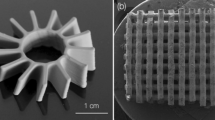Abstract
The possibility of fabricating SiC ceramics using special wood-based materials has been shown in previous research. To form accurate SiC bodies from wood-based green templates, special shaping techniques are necessary to fulfill the requirements on the finished ceramic products. Due to the fact that wood-based green templates undergo shrinkage during carbonization, no suitable forming processes for the wood-based green templates have been presented so far. In this publication different raw materials and 3D shaping production processes and their influence on green body properties are described. It was possible to produce green bodies with a MOR higher than 15 N/mm² and a density in the range above 0.82 g/cm³. It is shown that reduction of resin content decreases the strength significantly and a reduction to 30 mass % resin content reduces the MOR of flat pressed panels to the defined limit. The extruded samples showed a significantly lower strength (mean 18.1 N/mm², standard deviation 8.6 N/mm²). Injection molding was not applied successfully. The findings show that shape pressing and extrusion were applied successfully, but the green body properties differed significantly from the results achieved by flat pressing.
Zusammenfassung
Vorhergehende wissenschaftliche Untersuchungen haben bereits die Möglichkeit der Herstellung von SiC-Keramiken aus speziellen Holzwerkstoffen dargestellt und dabei durch spezielle holzbasierte Grünkörper vergleichbare Eigenschaftsprofile von herkömmlichen Hochleistungskeramiken erreicht (z. B. Sinterkeramiken). Um holzwerkstoffbasierte, maßstabsgetreue SiC-Körper herstellen zu können, die die Anforderungen von keramischen Produkten erfüllen, sind jedoch spezielle Formgebungsverfahren erforderlich. Auf Grund der Tatsache, dass holzbasierte Grünkörper während des Carbonisierungsprozesses einer Schrumpfung unterliegen, konnten aber bisher noch keine geeigneten Verfahren zur Umformung von komplex geformten holzwerkstoffbasierten Grünkörpern dargestellt werden. In dieser Publikation werden verschiedene Ausgangsrohstoffe und 3D-Gestaltungs-/Produktionsprozesse und deren Einfluss auf die Grünkörpereigenschaften beschrieben. Es konnten Grünkörper mit einem MOR höher als 15 N/mm² und einer Dichte von über 0,82 g/cm³ hergestellt werden. Des Weiteren konnte ein deutlicher Einfluss des Harzgehaltes auf die Festigkeit nachgewiesen werden, so dass sich bei einer Reduktion des Harzgehaltes auf 30 Masse- % der MOR von im Flachpressverfahren hergestellten Platten bis zum Grenzwert verringerte. Extrudierte Probekörper zeigten signifikant geringere Festigkeitswerte (Mittelwert 18.1 N/mm², Standardabweichung 8.6 N/mm²). Das Spritzgussverfahren konnte nicht erfolgreich angewendet werden. Die Ergebnisse zeigen jedoch, dass sich das Formpressen und die Extrusion erfolgreich anwenden lassen, dabei aber deutliche Abweichungen der Grünkörpereigenschaften zum Flachpressverfahren vorliegen.









Similar content being viewed by others
References
Ashby MF (2011) Materials selection in mechanical design, 4th edn. Butterworth-Heinemann/Elsevier, Amsterdam
Byrne C, Nagle D (1997) Carbonization of wood for advanced materials applications. Carbon 35(2):259–266
EN 310 (1993) Wood-based panels; determination of modulus of elasticity in bending and of bending strength
EN 322 (1993) Wood-based panels; determination of moisture content
EN 323 (1993) Wood-based panels; determination of density
EN 325 (1993) Wood-based panels; determination of dimensions of test pieces
EN 622-5 (1997) Fibreboards—specifications—part 5: requirements for dry process boards (MDF)
Gadow R (1986) Die Silicierung von Kohlenstoff. Dissertation, Universität Karlsruhe, Germany
Greil P, Lifka T, Kaindl A (1998a) Biomorphic cellular silicon carbide ceramics from wood: I. Processing and microstructure. J Eur Ceram Soc 18(14):1961–1973
Greil P, Lifka T, Kaindl A (1998b) Biomorphic cellular silicon carbide ceramics from wood: II. Mechanical properties. J Eur Ceram Soc 18:1975–1983
Hofenauer AF (2005) Entwicklung spezieller Holzwerkstoffe für die Herstellung Silicium-infiltrierter Siliciumkarbid-Keramik. Dissertation. Technische Universität München, Germany
Hozer L, Lee JR, Chiang YM (1995) Reaction infiltrated, netshape SiC composites. Mat Sci Eng A 195:131–143
Krenkel W (2000) Entwicklung eines kostengünstigen Verfahrens zur Herstellung von Bauteilen aus Keramischen Verbundwerkstoffen. Dissertation, Germany
Krenkel W, Hall S, Seiz S (1999) Biomorphe SiC-Keramiken aus technischen Hölzern. DGM-Tagung “Verbundwerkstoffe und Werkstoffverbunde”, Hamburg 5–7, Oktober 1999
Martínez-Fernández J, Valera-Feria F, Singh M (2000) High temperature compressive mechanical behavior of biomorphic silicon carbide ceramics. Scripta Mater 43:813–818
Müller U, Braun J, Haider A, Nguyen HL, Roth M, Endesfelder A, Panzer U (2008) Melaminharzbasierende duroplastische WPC—Herstellung und Eigenschaften. Holztechnologie 49(1):20–26
Qiao G, Ma R, Cai N, Zhang C, Jin Z (2002) Mechanical properties and microstructure of Si/SiC materials derived from native wood. Mater Sci Eng A323(1–2):301–305
Rätzsch M (2003) Extrudable wood—melamine resin composites—an overview. In: Institut für Holzforschung (Hg.): Proceedings of the international symposium on wood based materials—wood composites and chemistry. Universität für Bodenkultur, Wien. Lignovisionen 25–32
Sangsuwan P, Tewari S, Gatica J Singh M, Dickerson R (1999) Reactive infiltration of silicon melt through microporous amorphous carbon preforms. Metall Mater Trans B 30B:933–944
Schmidt J, Hall N, Seiz S, Krenkel W (2001) Microstructure and properties of biomorphic SiSiC ceramics derived from pyrolysed wooden templates. In: Proceedings of the 4th international conference on high temperature ceramic matrix composites (HTCMC4), München, 1–3 October, 2001
Sieber H, Zollfrank C, Weisenesel L, Greil P (2003) SiSiC-ceramic composites from biocarbon powder. Presented at 8th Conference and Exhibition of the European Ceramic Society Istanbul/Turkey, June 29th–July 3rd, 2003
Siegel S, Petasch U, Weiss R (2002) Biomorphous ceramic composites. Presented at 9th annual international conference on composites engineering, July 1–6, 2002 San Diego, pp 725–726
Singh M, Behrendt D (1994) Microstructure and mechanical properties of reaction-formed silicon carbide (RFSC) ceramics. Mater Sci Eng A187:183–187
Acknowledgments
The authors acknowledge financial support from the Austrian Research Promotion Agency (FFG) under “Fabrik der Zukunft” Project Number 812 348. We gratefully acknowledge the support of Wood K plus Wels (Upper Austria) by producing extruded green body samples and SGL Carbon for supporting the project. Furthermore the support of the regional government of Salzburg is acknowledged.
Author information
Authors and Affiliations
Corresponding author
Rights and permissions
About this article
Cite this article
Lohr, J., Treusch, O.G., Standfest, G. et al. Production process of wood-based materials for SiC Ceramics. Eur. J. Wood Prod. 71, 417–428 (2013). https://doi.org/10.1007/s00107-013-0692-5
Received:
Published:
Issue Date:
DOI: https://doi.org/10.1007/s00107-013-0692-5



